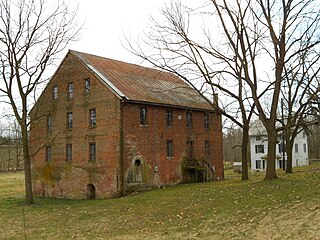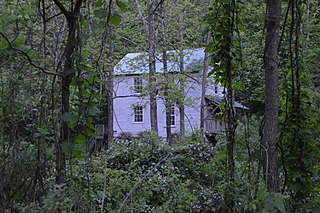
Ivory Mills is a 14-acre (5.7 ha), historic grist mill complex located at White Hall, Harford County, Maryland, United States. It consists of six standing 19th century frame buildings and structures: mill, miller's house, barn, corncrib, carriage house, and chicken house. The property also includes the ruins of a stone spring house, and the stone abutments of a frame, Federal-era covered bridge. The focus of the complex is the three-story stone and frame mill building built about 1818. The ground story is constructed of coursed stone rubble and the upper stories are clapboard. The family first started a mill on this site in 1781, and this mill ceased functioning in the 1920s.

Donegal Mills Plantation is a historic grist mill complex located at East Donegal Township, Lancaster County, Pennsylvania. The complex consists of the mill, mansion, miller's house, and bake house. The mill was built in 1775, and is a three-story building. The original section of mansion was built before 1790, and is a two-story, stuccoed stone building with a gable roof. The mansion was expanded about 1820, with a frame kitchen wing, and about 1830, with a stone two-story addition. It features a full length, two-story, porch supported by five brick and stucco columns. The miller's house was originally built about, and is a 3 1/2-story, stuccoed stone building with a gable roof. It was expanded to its present size about 1830. The bake house is a two-story, gable roofed frame building. The property was auctioned in May 2010.

The Newlin Mill Complex, also referred to as The Newlin Grist Mill, is a water-powered gristmill on the west branch of Chester Creek near Concordville, Pennsylvania was built in 1704 by Nathaniel and Mary Newlin and operated commercially until 1941. During its three centuries of operation, the mill has been known as the Lower Mill, the Markham Mill, the Seventeen-O-Four Mill and the Concord Flour Mill. In 1958 the mill property was bought by E. Mortimer Newlin, restored and given to the Nicholas Newlin Foundation to use as a historical park. Water power is still used to grind corn meal which is sold on site. The park includes five historical buildings, which were added to the National Register of Historic Places in 1983, and 150 acres (61 ha) of natural woodland.

The New Hope Mills Complex is a historic grist mill complex located on Glen Haven Road near the intersection with Route 41A in the hamlet of New Hope in the town of Niles in Cayuga County, New York. The complex includes the mill building, two vernacular dwellings, a 1910s gambrel roofed storage barn, a 1935 saw mill, two concrete faced dams, and a 1-acre (4,000 m2) mill pond.

Harrison Grist Mill, also known as Morley Grist Mill, is a historic grist mill located at Morley in St. Lawrence County, New York. It was built about 1840 and is a rectangular random ashlar, cut sandstone building with a simple gable roof.

Hanford Mills Museum, also known as Kelso Mill, is a historic grist mill and sawmill and national historic district located at East Meredith, New York in Delaware County, New York. The district contains nine contributing buildings and three contributing structures. The complex includes both natural and structural facilities. It includes a mill race from Kortright Creek to the damned up Mill Pond which supplies the waterwheel, a spillway for the pond's overflow, a section of old New York Central Railroad track, two railroad bridges crossing Kortright Creek, and a variety of buildings. The main structure is a mill building dating to the 1820s with additions from the 1870s, 1880s, and 1890s. The four story wood frame structure is approximately 150 feet long and 120 feet high. Also on the property is a one-story depot building with grain elevator and storage facilities. It is now operated as a museum. It was listed on the National Register of Historic Places in 1973.

Homan-Gerard House and Mills is a historic home and mill complex located at Yaphank in Suffolk County, New York. It is composed of a large Federal-style residence, four contributing related support buildings, and six contributing related archaeological sites. The house is a 2 1⁄2-story frame residence with a three-bay facade, gambrel roof, center chimney, and kitchen wing. Also on the property are three small sheds and a large 2-story, late-19th-century barn. Archaeological remains include that of the J. P. Mills Store and Homan-Gerard saw mill and grist mill.

John A. DeBaun Mill is a historic grist mill located at Tallman in Rockland County, New York. It was built about 1845 and is a two-story, four by two bay, heavy timber frame, clapboard sheathed main block on a rubble stone foundation. The main block is flanked by large shed roofed one story wings. The property includes the mill building, a portion of the mill stream, and the site of the mill pond. It regularly functioned as a mill until 1906.

Stone Grist Mill Complex is a historic grist mill complex located at St. Johnsville in Montgomery County, New York. The complex consists of the mill, the remains of a stone impoundment dam, the mill owner's house, bar, wagon shed, and hog house. The mill was built about 1835 and is a 30 by 50 feet gable roofed structure constructed of rough cut, native limestone block laid in random ashlar. The mill is now occupied by a bed and breakfast.

Haviland-Davison Grist Mill is a historic grist mill located at East Rockaway in Nassau County, New York. It was restored and relocated to its present site in Memorial Park in 1963. It was built about 1689 and is a 2 1⁄2-story, "T" shaped, timber frame building. The original section has one large addition and two smaller wings attached to each side.

Union Bryarly's Mill is a historic flour and grist mill complex and national historic district located at Darkesville, Berkeley County, West Virginia. It encompasses four contributing buildings and two contributing sites. The buildings are the Bryarly Mill, Mansion House, log smokehouse and combination ice house building, log miller's house (1751), site of a distillery, and foundation containing archaeological remains. The mill was built about 1835, and is a two-story, three-bay brick building with a gable roof. The Mansion House was built about 1835, and is a two-story, L-shaped frame dwelling on a stone foundation.

Clear Spring Mill is a historic mill complex located at Franklin Township, York County, Pennsylvania. The complex includes the grist mill, sawmill, and corn crib. The grist mill was built in 1886, and is a 2 1/2-story, heavy timber frame building on a banked sandstone foundation. It has a gambrel roof and three interior levels. The sawmill was built about 1809, and is a one-story timber frame building on a foundation of banked stone, stone piers, and wood posts. It measures 12 feet deep by 40 feet wide, with a rear porch extension. The corncrib was built about 1930.

Mascot Roller Mills, also known as Ressler's Mill, is a historic grist mill complex located at Upper Leacock Township, Lancaster County, Pennsylvania. The complex consists of the mill, miller's house, summer kitchen, and frame barn. The original section of the mill was built in 1737. The machinery was installed in 1906. It is a three-story, "L"-shaped stone building with a gable roof and cupola. The house was built in 1855, and is a two-story, gable roofed brick banked building. The summer kitchen is adjacent to the house is a one-story, brick structure. The small frame barn dates to the late-19th century. It is the oldest continuously operating grist mill in Lancaster County.

Jervis Gordon Grist Mill Historic District, also known as Milford Grist Mill and Rowe's Mill, is a historic grist mill and national historic district located at Milford, Pike County, Pennsylvania. The district includes three contributing buildings and one contributing structure. The buildings are a late-19th century grist mill, blacksmith complex, and millers house. The contributing structure consists of the mill pond, dam, head race, and tail race.

Willow Mill Complex is a complex of historic buildings located at Richboro, Northampton Township, Bucks County, Pennsylvania. The complex consists of the Shaw-Leedom House and spring house / smoke house and the Howard Sager House, wagon house, and grist mill. The Shaw-Leedom House was built about 1800, and is a 2 1/2-story, five bay, stone dwelling with a gable roof in the Federal style. It has a 1 1/2-story, two-bay stone wing believed to be the kitchen wing from an earlier house. The adjacent stone spring / smoke house was also built about 1800. The Willow Mill was built in the 1840s, and is a four-story stone building converted to residential use in 1938. The Sager House was built in 1847, and is a 2 1/2-story, three bay, ashlar stone building. It has a gable roof with dormers and shed roof "Dutch Stoop" kitchen wing. Associated with it is a two-story, frame wagon house dated to the 19th century.

Graves Mill, also known as Jones Mill and Beech Grove Mill, is a historic grist mill complex located near Wolftown, Madison County, Virginia. The complex includes a three-story, heavy timber frame gristmill; a two-story, log, frame, and weatherboard miller's house; and a one-story heavy timber frame barn. The gristmill was built about 1798, probably on the foundation of an earlier gristmill built about 1745. It was owned and operated by members of the Thomas Graves family for more than a century.

Goblintown Mill, also known as Turner's Mill, Wood's Mill, Walker's Mill, and Martin's Mill, is a historic grist mill complex located near Stuart, Patrick County, Virginia. The mill dates to the 1850s, and is a two-story, timber frame building on a dry stone foundation. The mill retains its original mill race and milling machinery. Associated with the mill is a 1 1/2-story, frame "storehouse" that housed a general store and dwelling. It was built about 1902.

The Old Grist Mill is a historic mill building on Little River Road in eastern Lebanon, Maine. Built in 1774, it is the town's oldest surviving industrial building, and was in operation as a mill into the 20th century. The building, listed on the National Register of Historic Places in 1975, has been converted into a residence and retail/artist space.

The Dexter Grist Mill, now the Dexter Historical Society Museum, is a historic 19th-century industrial property in Dexter, Maine. Built in 1854, the mill was operated by a single family for over a century, and was converted to a museum in 1967. It was listed on the National Register of Historic Places in 1975.

The Cargill Falls Mill, also known historically as the Wilkinson Mill, is a historic textile mill complex at 52-58 Pomfret Street in Putnam, Connecticut. Founded in 1806, it is one of the state's oldest mill complexes, and it retains examples of mill architecture spanning more than 175 years. It was listed on the National Register of Historic Places in 2014.






















